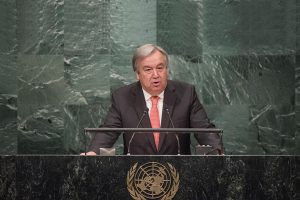By Elena Kosolapova, Senior Policy Advisor, IISD Tracking Progress, and SDG Hub Content Editor
The world is facing unprecedented challenges. The COVID-19 pandemic, conflicts, food and energy insecurity, and the triple crisis of climate change, pollution, and biodiversity loss have derailed progress on the SDGs. Crippling sovereign debt has further deepened the divide between developing and developed countries, putting inclusive and sustainable development at risk.
The UN Trade and Development Conference (UNCTAD) estimates global growth to be lower than earlier projected, signaling a potential economic downturn. Combined with mounting debt and insufficient international support, this could put developing countries at risk of “another lost decade.”
The UN Secretary-General António Guterres has repeatedly emphasized the need to radically transform the global financial architecture to ensure “it delivers effectively and fairly for everyone” and works for people, planet, and prosperity, calling for a global financial system where the needs of developing countries are placed at the center of every decision and mechanism.
The UN, the International Monetary Fund (IMF) and the World Bank, as well as international experts have made recommendations and proposals aimed at adapting the global financial architecture to today’s global challenges to overcome the multidimensional crises, restore debt sustainability, and “rescue” the SDGs.
Why reform?
In May, the UN Secretariat published a policy brief outlining the Secretary-General’s recommendations on reforming the international financial and tax architecture. The publication is the sixth of 11 policy briefs that elaborate on the proposals contained in Our Common Agenda (OCA) by offering “concrete ideas” to advance work. Developed taking into account Member States’ guidance and intergovernmental and multi-stakeholder consultations, the policy briefs are intended to contribute to preparations for the Summit of the Future in 2024, which is expected to “agree on multilateral solutions for a better tomorrow.”
OCA Policy Brief 6 titled, ‘Reforms to the International Financial Architecture,’ explains that the global international financial architecture dates back to 1945 when it was designed “by and for the industrialized countries of the post-war period.” As such, the brief notes, it has become increasingly at odds with the realities, needs, and challenges of today and is now “entirely unfit for purpose” in a world where climate change, increasing systemic risks, inequality, “highly integrated financial markets vulnerable to cross-border contagion,” and geopolitical changes are putting sustainable development to the test.
Among the inequities, gaps, and inefficiencies “deeply rooted” in the financial architecture, the brief highlights:
- Higher borrowing costs for developing countries, with many governments having to allocate a high share of revenue to debt service payments instead of investing in health, education, and social protection;
- Massive variation in countries’ access to liquidity in times of crisis, with Africa receiving only 5.2% of the latest issuance of special drawing rights (SDRs);
- Vast underinvestment in global public goods, such as pandemic preparedness and climate action; and
- Volatile financial markets and capital flows, recurring global financial crises, and sovereign debt distress.
The brief also highlights the international tax architecture’s failure to keep pace with a changing world, with global tax evasion restricting countries’ ability to rely on national resources to finance investment in their sustainable and equitable development.
How to go about it
The policy brief warns that without urgent action, the gap between haves and have-nots “will translate into a lasting divergence … and geopolitical fractures,” leading to “eventual fragmentation of international financial and economic relations.” Therefore, the Secretary-General calls for ambitious reform of the international financial architecture to ensure it is structured to support the SDGs and human rights through “more inclusive, representative and, ultimately, more effective global economic governance.”
To achieve this, the policy brief offers recommendations in six areas. To reform and strengthen global economic governance, it calls for transforming the governance of international financial institutions (IFIs) and for creating a representative apex body to systematically enhance coherence of the international system.
To deliver debt relief and lower the cost of sovereign borrowing, the policy brief recommends reducing debt risks and enhancing sovereign debt markets to support the SDGs. It calls for enhancing debt crisis resolution through a two-step process: a debt workout mechanism to support the common framework; and, in the medium term, a sovereign debt authority.
To scale up international public development and climate financing, the Secretary-General suggests:
- A massive increase in development lending and improved terms of lending;
- Changes to the business models of multilateral development banks (MDBs) and other public development banks to focus on SDG impact, as well as leveraging private finance more effectively for SDG impact;
- Massive increases to climate finance, while ensuring additionality;
- More effective use of the system of development banks to increase lending and SDG impact; and
- Ensuring that the poorest can continue to benefit from the MDB system.
To strengthen the global financial safety net and provide liquidity to countries in need, the policy brief urges strengthening liquidity provision and widening the financial safety net, and addressing capital market volatility.
The Secretary-General indicates that to reset the rules for the financial system to promote stability with sustainability, policy and regulatory frameworks are needed that address short-termism in capital markets, better link private sector profitability with sustainable development and the SDGs, and address financial integrity. More specifically, he recommends strengthening regulation and supervision of bank and non-bank financial institutions to better manage risks and rein in excessive leverage, making businesses more sustainable and reducing greenwashing, and strengthening global financial integrity standards.
Finally, to redesign the global tax architecture for equitable and inclusive sustainable development, the policy brief recommends:
- Strengthening global tax norms to address digitalization and globalization through an inclusive process, in ways that meet the needs and capacities of developing countries and other stakeholders;
- Improving pillar two of the proposal by the OECD/G20 Inclusive Framework on Base Erosion and Profit Shifting to reduce wasteful tax incentives, while better incentivizing taxation in source countries; and
- Creating global tax transparency and information-sharing frameworks that benefit all countries.
Way forward
In conclusion, the Secretary-General notes that the failure of the current international architecture to support long-term stable financing for the SDGs drives divergence and fragmentation and poses “a growing and systemic threat to the multilateral system itself.” Ambitious reforms, he argues, will help avoid such outcomes. According to the Secretary-General, his proposed package of action-oriented recommendations should be seen as “a paradigmatic shift in the structuring of international economic and financial relationships,” needed to “support the convergence of countries” towards more inclusive and sustainable development, “aligned with the [SDGs] and anchored in ‘beyond GDP’ metrics.”
OCA Policy Brief 6 reveals an urgent need for new forms of international cooperation, supported by an architecture that is “fit for purpose” in the 21st century “across the financial and monetary system, tax, trade, environmental stability and climate action, and other development issues.” The proposed measures to reform the international financial system can get us there.
* * *
In preparation for the 2023 SDG Summit and the Summit of the Future in 2024, the UN Secretary-General is launching eleven policy briefs between March and July 2023, offering “concrete ideas” on how to advance Our Common Agenda. Timed accordingly, the SDG Knowledge Hub is publishing a series of policy briefs of its own, offering insights on the issue areas covered in these publications.

